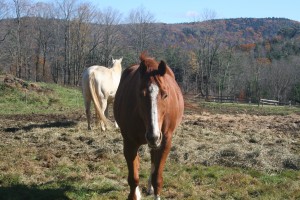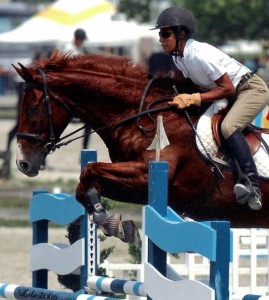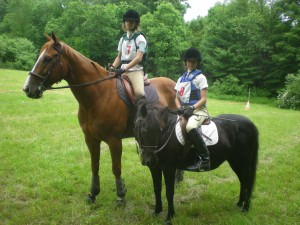Natural Horsemanship veteran Farah DeJohnette’s methodology starts in the stall.
The “home visit” figures right up there among other important details of buying a horse, from physical conformation to a clean bill of health. This is tantamount to choosing any breed, Warmblood, Thoroughbred or something else.
Stating she has a “knack” for picking low-key Thoroughbreds in this way, DeJohnette says, “I go into the stall because that’s where the horse is who he is. This is where he lets down his track energy.”
And the results speak for themselves. In her 20 years training horses through a method that gains an equine’s trust and cooperative spirit, she has taught her Warmblood to jump with her, at a canter, and without a bridle! And Thoroughbreds and other breeds have been taught to loosen, relax and work collaboratively in disciplines, which include trail riding, dressage, hunter/jumper and reining.
Race name: Homeland Security
New name: AKA James
Sire: Corporate Report
Dam: Sportin’ Woman
Foal date: April 2, 2001
In his stall at Penn National is where DeJohnette met her all-time favorite horse, an off-track Thoroughbred named Homeland Security, now known as James.
“When I met James in his stall, he was the most soft, friendly horse I’d met. He turned his head to me as if to say, ‘Don’t you just want to love on me?’ It was as though he was asking me to rub his face and hug him.”
Her years of experience had shown her that horses who are flighty, or flinch away from the touch in their stall may have personality issues to overcome. By contrast, she recognized James as an equine gem.
Working through a service called Mix n’ Match, which helps connect buyers with off-track Thoroughbreds, DeJohnette found the 16-hand Chestnut with white blaze and socks roughly three years ago.
He was the type of horse that nobody could pass by without commenting. “Everybody would tell me James was such a nice horse and he really was,” she says. “His energy is so kind and sweet and gentle.”
She laughs now when she thinks about how his personality first affected her. “I imagined he felt a little dejected because he wasn’t a good racehorse,” DeJohnette says. “I always talk to the horses and I told him I thought I had a job for him that he’d be really good at.”
She proved correct.
After four or five months of training, James was purchased by a young girl, and ran “double-clean” is his first event years ago. He went on to finish in the top six at numerous horse trials. “He jumped cross country, did a dressage test, and did all the natural jumps, and he didn’t have any penalties.
“He started a totally new career, in a new environment, and he just went out and did it like he’d been doing it his entire life.”
James was rare, true, but his story of transitioning from the racetrack into a successful off-track life through Natural Horsemanship training, is not unusual one.
By working with a horse’s natural herd instinct, Natural Horsemanship techniques attempt to build order, trust, and establish bonds that closely resemble relationships that exist naturally between horses.
It has worked so well with Thoroughbreds she has trained that there have been times she has suggested an ex-racehorse might fit a client’s bill better than a Warmblood.
“I work in the show world surrounded by a lot of people who have this notion, ‘I want a warmblood.’ I tell them the Thoroughbred is often a better horse, purely from a technical standpoint. And they’ll tell me, ‘Well, it’s just a Thoroughbred.’
“But I’ve realized that I can train a Thoroughbred into being a highly competitive sport horse that won’t break the bank.”
A natural tendency to want to work combined with Natural Horsemanship is a combination that often brings out the best in Thoroughbreds, DeJohnette says.
“To me, Natural Horsemanship was invented for track horses, and horses who have lived in a high-alert state,” she says.
Through trust-building exercises and inducements to bring out the horse’s desire to want to do a task, she has been rewarded by the horse’s willingness to partner up.
After all, the horse is ultimately “choosing” whether to cooperate or not, she notes.
“I don’t care how much restraint you put on a 1,200 pound horse. If he’s frightened, he can snap a leather strap so easily. The point is to let him choose to work,” DeJohnette says. “I always tell people a horse is not under control to me unless he’s choosing to be under control. After all, I’ve been on many horses in my life who don’t care what’s in their mouth. When they decide they’re done, they’re done.”
But when they decide they’re part of your team, and they’re willing, there’s nothing like it. And factor in a Thoroughbred, and the combination can be very winning.
“I have Warmbloods, and they’re great. But I just have a soft spot for Thoroughbreds. And when they go to a show, if they want to work for me, it gives them a real competitive edge against horses who are coerced to work.”
(Please see DeJohnette jumping Mercury, her gelding, without a bridle).





I too have a Corporate Report gelding, Einstein. He used to be Jake’s Corporate Jet. Now at age 4 he is the best horse I have ever had the pleasure to ride and own. My trainer is so in love with him that she is looking for more… Anyone out there that knows of or needs to sell a Corporate Report baby???
Yeah I explain it like this some horses have the instinct to jump or do dressage or herd cattle. Whether it’s breeding or just inborn just like a boarder collie wants to herd. When we say a horse has a lot of “cow” we are saying he has the instinct to do it. We just fine tune it with training.
That’s great Farah. So much better to work with the horse’s instincts rather than bracing against them.
Well said, DeJohnette! I love it!
The classic question is, of course, “Do you force horses to run/jump/etc.?”
And I always have to laugh – you’re not forcing a horse to do anything – that horse is bigger than you and if hasn’t figured it out yet – he will!
I have had SUCH luck with common sense “natural horsemanship,” just in getting in synch with a horse, making it easy and natural for a horse to do the right thing, and since I pretty much have exclusively ridden Thoroughbreds for years, naturally I quite agree that such methods work very well on OTTBs.
Possibly more so, than with a Warmblood or draft, because it is easier to gain and keep their focus – they’re so interested in working, having a job, putting their skills and athleticism to use.
You’re so right Natalie! I’ve had people ask me things like, well, does the horse LIKE to jump, or is he just being forced to do it. I’d invite them to come watch a jumper in the ring when he’s having a little indoor turnout. Because they will jog around and go over a few, just for the fun of it. And what Farah says about a horse letting you know when he’s “done” with something is so painfully true.
Anyway, thanks for your comment!!